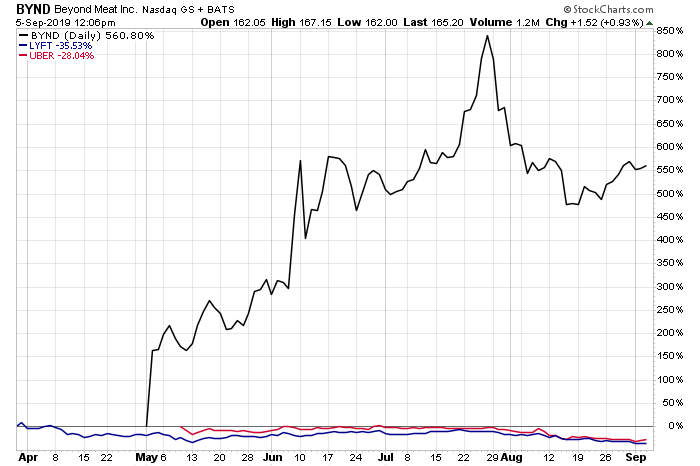What Made These Tech IPOs Suffer—and Why BYND Is One of the Top Stocks in 2019
Marijuana Business, Stocks, Finance, & Investing September 10, 2019 MJ Shareholders 0


Tech IPOs in 2019
Technology initial public offerings (IPOs) in 2019 have been anything but consistent. While in years past, a tech stock going public was a fairly reliable way to score big gains in your portfolio, the biggest such stocks in 2019 have had uneven rides so far.
While some tech stocks have gained astronomically, even going as high as 500% over their IPO prices, others have seen their prices plummet. So what happened? And more importantly, what can investors learn from these tech IPOs?
Three tech stocks we’ll be looking at today are Lyft Inc (NASDAQ:LYFT), Uber Technologies Inc (NYSE:UBER), and Beyond Meat Inc (NASDAQ:BYND). The first two, both ride-sharing apps, are down significantly since their respective IPOs.
In roughly the same period, Beyond Meat stock has skyrocketed 560% over its IPO price in about four months. Those types of gains are exceedingly rare, and while it may be too late to see another 500% from this stock in the next four months, how can we use this information to identify the next big trend in tech stocks?
Chart courtesy of StockCharts.com
While there are a host of reasons why LYFT stock and UBER stock have performed so poorly and BYND stock has killed it in the stock market, I believe that, on a fundamental level, it comes down to this: innovation.
Tech stocks became the cash cows of the 21st century is precisely due to innovation. Online shopping, social media, computers, the Internet, mobile phones—these have all radically redefined the way we live our lives. And they have led to boosts in stock prices commensurate with just how much they have changed the world.
Ride-sharing apps were innovative when they first hit the market—the operative word being “were.”
Let’s compare ride-sharing apps to Facebook, Inc. (NASDAQ:FB). The social media platform was first available to the public in 2006, and the company had already achieved positive cash flow by 2008. By the time FB stock first went on the market in 2012, the company was nearing one billion users and was making money.
Ride-sharing apps, on the other hand, took a decidedly different turn. First, they came late in the tech boom, when tech IPOs were becoming more and more commonplace. It seemed that everyone had a killer app that was destined for stock market dominance. We had a lot of companies highlighting their growing user numbers without ever really showing how they were going to make money.
We had years of hype leading up to the big ride-sharing app IPOs, with both LYFT stock and UBER stock having been rumored for ages to be hitting the public market.
Worse yet, these companies were spending money like crazy and seeing their valuations continue to balloon to absurd numbers. Uber, at one point, had by some estimates a valuation of over $100.0 billion, without ever having recorded a profit. When analysts and investors see that, they get scared, they see bloat.
And all that hype and buildup resulted in exactly that situation for LYFT stock and UBER stock: investor skittishness and two flops, one following the other. The two companies waited too long and missed their opening.
Now, contrast that with Beyond Meat stock.
The company did not spend years pussyfooting about whether it would enter the stock market. Management didn’t drive up its spending continuously without an end in sight. Beyond Meat didn’t even play up its tech angle all that much, even though it’s very much a tech company.
Sure, technology isn’t usually of the edible variety, but Beyond Meat is an innovative product that was born out of research, development, and technological breakthroughs. Contrasted with, say, a new soda that anyone could have made with the current ingredients available and simply never did, this is a product that required rigorous innovation to exist.
BYND stock performed so exceptionally primarily due to timing, is what I’m getting at. This company struck while the iron was hot, leaping into an uncrowded market with a product that clearly interested consumers around the world and met a need: a plant-based alternative to meat that tastes good.
This was a product that people actually wanted and that they didn’t already have for years. Uber, on the other hand, has pretty much completed the vast majority of its business growth. Self-driving cars notwithstanding, it’s hard to see the company growing exponentially in the coming years. No such limit exists for Beyond Meat.
All this comes together to help propel a company that is truly innovative and fresh to stock market success, while Lyft and Uber have been mired in difficulty. They were stale while Beyond Meat was exciting, they were old news while Beyond Meat was novel, and they were too bloated while Beyond Meat was lean.
That’s why BYND stock is up by more than 500% while LYFT stock and UBER stock are so far behind.
BYND Stock Prediction
Beyond Meat stock looks like it’s continuing to surge, and its recent quarterly report was extremely positive.
The company showed net revenues of $67.3 million, an increase of 287% from last year. Gross profit was $22.7 million (33.8% as a percentage of net revenues), compared to gross profit of $2.6 million (15% as a percentage of net revenues) a year prior. (Source: “Beyond Meat Reports Second Quarter 2019 Financial Results,” Beyond Meat Inc, July 29, 2019.)
Net loss was $9.4 million ($0.24 per common share), compared to net loss of $7.4 million ($1.22 per common share) the same time a year ago.
While there’s still no net profit, gross profit is certainly a good start. Furthermore, Beyond Meat has become a buzzword among stock investors due to its amazing rise and the otherwise blind eye that many investors had for this particular industry.
After all, meat-alternative products did not have all the media fanfare that other nascent industries had. That has all changed now, following Beyond Meat’s massive commercial success.
The question is whether the company can continue to grow. Remember that other nascent-industry IPOs had similar early success, only to see much of it wiped out in a war of attrition.
The company that most readily comes to mind is the marijuana company Tilray Inc (NASDAQ:TLRY), whose stock had massive growth post-IPO but declined steadily for months following its peak.
These are very different companies operating in completely different industries, mind you, but Tilray served as an example of the worst-case scenario.
But I don’t think that’s likely. Instead, I think we’ll see BYND stock begin to taper off as time goes on. After all, it can’t keep this pace up forever.
The good news is that the potential is still running strong in the meat-alternative business. There are thousands upon thousands of restaurants around the world that have yet to offer a plant-based meat alternative on their menu. As this industry grows and the trend continues, expect to see Beyond Meat and its competitors vie for dominance in this space.
The next big fight is over McDonalds Corp (NYSE:MCD) and its global fast-food empire. If Beyond Meat can win that battle, expect to see huge gains for its stock. (Source: “The Hottest Thing in Food Is Made of Peas, Soy, and Mung Beans,” Bloomberg Businessweek, August 21, 2019.)
LYFT Stock and UBER Stock
Despite my criticism of both Lyft and Uber, I still believe there is value to be salvaged. Both companies are world-class and have huge consumer bases. Both are looking toward future growth, both in terms of adding more riders and offering more traveling alternatives (think self-driving cars).
The problem with both companies is that they are spending way too much money and they keep promising that it will all pay off tomorrow. But “tomorrow” keeps getting put off and some investors are concerned that tomorrow may never come. I don’t believe that, but I do believe that investors will likely have to play the long game with LYFT stock and UBER stock.
Right now, Lyft just got a boost from Deutsche Bank AG (NYSE:DB), which initiated coverage for the company at a “buy” rating, with a $70.00 price target. (Source: “Deutsche Bank initiates Lyft with a buy rating, says the struggling recent IPO ‘may be bottoming’,” CNBC, September 5, 2019.)
LYFT stock, as of this writing, is trading around $45.00. That represents significant upside and is predicated on the idea that the stock has bottomed out and now has nowhere to go but up.
“We initiate coverage of Lyft with a Buy rating and think the stock may be bottoming. The company reported robust 2Q results, and yet the stock has been weak,” wrote Deutsche Bank’s research analyst Lloyd Walmsley.
“We think the recent sell-off in Lyft’s shares presents an attractive entry point, particularly for longer-term investors who can stomach a period of volatility given the uncertainty around when the market will start to give the company credit for an improving ramp towards profitability.”
I agree largely with the above. These are companies that have strong upside, but will need to take their licks early on, especially in the current economic climate.
These are very strong companies with potential for big stock gains, even well beyond their IPO prices, but those gains are going to be hard-won.
Analyst Take
Beyond Meat Inc played all its cards at the right time while Lyft Inc and Uber Technologies Inc simply held on to their cards for far too long. That has resulted in dramatically differing IPO stories for these companies.
While all three tech stocks have potential, Beyond Meat stock is the most exciting of them, even if there are several questions about the company’s future.
MJ Shareholders
MJShareholders.com is the largest dedicated financial network and leading corporate communications firm serving the legal cannabis industry. Our network aims to connect public marijuana companies with these focused cannabis audiences across the US and Canada that are critical for growth: Short and long term cannabis investors Active funding sources Mainstream media Business leaders Cannabis consumers









No comments so far.
Be first to leave comment below.